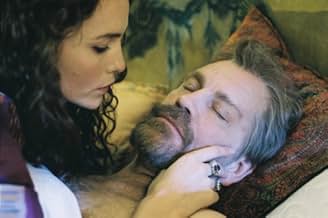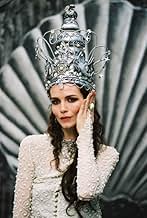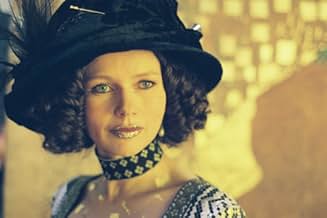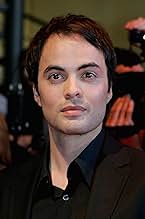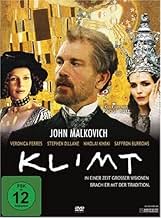Retrato del artista austríaco Gustav Klimt, cuyos retratos sexualizados simbolizan el estilo art nouveau de finales del siglo XIX.Retrato del artista austríaco Gustav Klimt, cuyos retratos sexualizados simbolizan el estilo art nouveau de finales del siglo XIX.Retrato del artista austríaco Gustav Klimt, cuyos retratos sexualizados simbolizan el estilo art nouveau de finales del siglo XIX.
- Dirección
- Guionistas
- Elenco
- Premios
- 1 premio ganado y 4 nominaciones en total
- Dirección
- Guionistas
- Todo el elenco y el equipo
- Producción, taquilla y más en IMDbPro
Opiniones destacadas
Hunter S. Thompson blew the journalistic world away by openly reporting events through the prism of his own drug-soaked experience. Terry Gilliam's cinematic portrayal of this in "Fear and Loathing in Las Vegas" conveyed this brilliantly.
So far as I know, Gustav Klimt did not portray his artistic vision in an ether-soaked stupor or in a state of syphilitic delirium. My problem with Mr. Ruiz portraying him as though he did is that Klimt actually led an exuberant revolutionary artistic movement in a city and continent exploding with creative energy, and this portrayal could hardly be farther from the truth. Even a non-linear poetic portrayal of the creative process should shed some truth on its essence.
The tone of the movie was static, suffocating, semi-conscious and joyless. Klimt's life was full of color, sexual experimentation and living life to its fullest, so it additionally seems odd that John Malkovich sleepwalks through his performance with less joy than Rod Steiger in "The Pawnbroker."
If Mr. Ruiz wanted to make a film about a fever-dream (Klimt died of pneumonia following a stroke, not of tertiary syphilis as suggested in the film), perhaps he should have entitled it "Fever-Dream: with a whimsical guest appearance by my fantasy of Gustav Klimt."
This film may be of use to film students to prove that images and sound do not automatically add up to a movie.
I didn't like this movie, and I have to say I admire Klimt paintings. I don't think that Klimt was so stiff and also sleepy. There is much more life in one simple photograph from the artist Wiki page, than in this whole movie. All these endless camera rotations around subjects! And too much too loud music... And actually an absence of scenario...
They tried to sell this movie to public - nudes, decadent atmosphere, this misleading label. The ratings show that they failed... I give it 5 for some visual enjoyment I had... and some women hats there were really-really amazing!
John Malkovich is talented but so quirky and full of himself he nearly ruins many of his movies. Surely he sees how affected he can sometimes be? Here he plays the Austrian artist Gustav Klimt in the years before WWI, and though we don't quite know what Klimt was like, we know he didn't play his life being John Malkovich. Biopics always struggle with the character against the actor, of course, since history is what it is, and so you swallow all this and see what the actor and the director can do within these constraints.
The director in this case is the late Raul Ruiz, the Chilean director who just died in Paris with a small cult following and a growing reputation. He concentrates not on Klimt's art, or even Klimt's attitudes as an artist of his time (this is the time of early Picasso, late Cezanne, and the growing influence of Gauguin). Instead it deals with Klimt's personality, which we know the least about, emphasizing his vulgarity, his obsession with nude women around him as much as possible, and his countless children for whom he apparently did as little as possible.
What might have been more interesting is to see a young Klimt being transformed by a 6th century Italian fresco with all its gold leafwork (this is true), or to maybe see him interact with the Vienna Secessionists in their effort, as a group, to break from the academy. What we get instead is a fantasy about the women around him, including a bizarre and willing entrapment of Klimt by a wealthy woman and her double (or twin?) which turns into a kind of erotic sex game with a man watching behind 2-way glass. Then there is a mysterious fellow who seems to only exist in Klimt's head--he's fascinating, yet only half realized.
If Ruiz had taken all this into something purely fantastic, where the trappings of history were shed, it might have been a transporting and special movie, an actual cinematic experience on its own terms. At times it tries, and there are some distortions and some beautiful moments, a bit out of place in the narrative, that stand on their own.
But mostly this lurches and jerks from situation to situation. The art is great, what we see of it, and the sets are nice, though even they are filmed too often with a yellowed dullness that defies the outrageous decorative beauty of the time. (I just happened to see "The Wings of the Dove" set in the same period and the set and costume design blows "Klimt" away). All of this is too bad especially for an art movie about an artist who believed in total aesthetic immersion--where everything, including your toilet paper holder, had to be an artistic component of a life of art.
It's not a disaster, but it's certainly a feminist's nightmare--where Klimt might have defended his painting of women as being honest and where the sex might have been free expression and liberation, the movie pushes all this into pure voyeurism and submissiveness. Women dangle and prance and decorate the movie sets, and your screen, the way Klimt, who was no feminist, might have approved, but which isn't accurate. It isn't about an equality in free loving sex, it's about women from a man's point of view. Period. Some of you will like that, but I did not.
I can imagine that the reason many people didn't like this movie was because it's not what they expected.
If you want to see a straight forward, biographical accurate movie about the life of Gustav Klimt, then this movie isn't for you.
The basic premise is that Gustav Klimt is lying on his death bed and in a manner of flashbacks you get to see random scenes about a fictitious story revolving around a mysterious woman. Blinded by the fever, the scenes appear surreal and deliver a feeling similar to what you may feel upon viewing Klimt's artwork.
There's no straight plot following this movie and the real Klimt may not have been the way he appears in the movie, but that was never intended anyway. What this movie does is brilliantly deliver an atmosphere very fitting to the Wiener Moderne. The very important "Kaffeehaus Kultur" at the time, where intellectuals of Vienna spent the entire day in coffee houses is portrayed very precisely as well.
I also think that Malkovich and Nikolai Kinski seem to be a near perfect cast for Gustav Klimt and Egon Schiele.
Anyway, if you've read this review and get the feeling that this movie is not for you, then don't watch it. But if you're intrigued by what you've read then by all means, go see this movie!
There's a commonality among those two and Klimt, and even between them and the more cerebral Budapest next generation. Its a matter of passion, sense (in both meanings) and concept curvature. While the two great art nouveau geniuses were wondering about space in Brussels and Barcelona, Klimt worked his space, curvature ans escape from the inside of women. Lots of women.
His work is of that type that is immediately attractive, so lots of people decorate with it. A brief familiarity with it breeds confusion, so unless you dig as deeply in viewing as he did in making, it will not connect. As a result, if you are serious about making a film of him, about him, you simply cannot do the normal thing: somehow artificially inducing drama into portraying a few known events. You cannot do what Greenaway did with Rembrandt, simply showing sexual passion and making the film painterly.
So along comes Ruiz, who is a strange bird, very much like Klimt. There's no middle familiarity with him. Either you know him deeply, you wrap your life where he has, or you miss the passion. You think him dull. You actually believe that someone would spend this much energy fine tuning the ordinary. Well, the thing about these three men is that they were their own worst critics. They all three created their own new worlds were none was before, worlds so perfect and pure anyone of lesser power would be unable to break them. Then they each turned on their own creation, finding and exploiting the weaknesses of their own creations, selves and now us. The art is not in the man but in how he made himself broken.
Look at each of them and see the beauty in partial dismemberment. Ruiz denotes this at the beginning with otherwise inexplicable, powerful amputee sex. As with Ruiz' best work, people act as others, split selves, whores of themselves, auditors and bureaucrats of sex. Love must be dissymmetric. Narrative to have power must be a bit jagged inside, where you want to go.
I admit, I think Malkovich was a bad choice. He really can be dull. But he is supposed to stagger through this, finding puddles of warm light, clean frames or open enclosure. The women are the thing, always the thing here and they are drawn well.
Ted's Evaluation -- 3 of 3: Worth watching.
¿Sabías que…?
- TriviaRyan Phillippe was considered for the role of Klimt.
- ErroresWhen Klimt mashes the cake in the man's face, the icing on the man's face is not covering his right eye. In the next close-up shot, there is a large blob of icing covering the man's right eye. In the next long shot when Klimt starts to wipe the man's face, the icing is no longer covering the man's right eye again.
- Citas
Klimt: Who art thou Asked the guardian of the night From crystal purity I come Was my reply And great my thirst, Persephone Yet heeding thy decree I take to flight and turn, and turn again Forever right I spurn the pallid cypress tree Seek no refreshment at its sylvan spring but hasten on toward the rustling river of Mnemosyne Wherein I drink to sweet satiety And there, dipping my palms between The knots and loopings of its mazy stream I see again, as in a drowning swimmers dream All the strange sights I ever saw And even stranger sights no man has ever seen
- Versiones alternativasA 131-minute-long Director's Cut was released theatrically in Austria and is available on DVD in the UK.
- ConexionesReferenced in Ricardo Aronovich, avec mes yeux de dinosaure du cinéma (2011)
Selecciones populares
- How long is Klimt?Con tecnología de Alexa
Detalles
- Fecha de lanzamiento
- Países de origen
- Sitios oficiales
- Idiomas
- También se conoce como
- A Viennese Fantasy à la manière de Schnitzler
- Locaciones de filmación
- Productoras
- Ver más créditos de la compañía en IMDbPro
Taquilla
- Total en EE. UU. y Canadá
- USD 97,656
- Fin de semana de estreno en EE. UU. y Canadá
- USD 2,332
- 24 jun 2007
- Total a nivel mundial
- USD 584,991
- Tiempo de ejecución2 horas 11 minutos
- Color
- Mezcla de sonido
- Relación de aspecto
- 1.85 : 1
Contribuir a esta página




